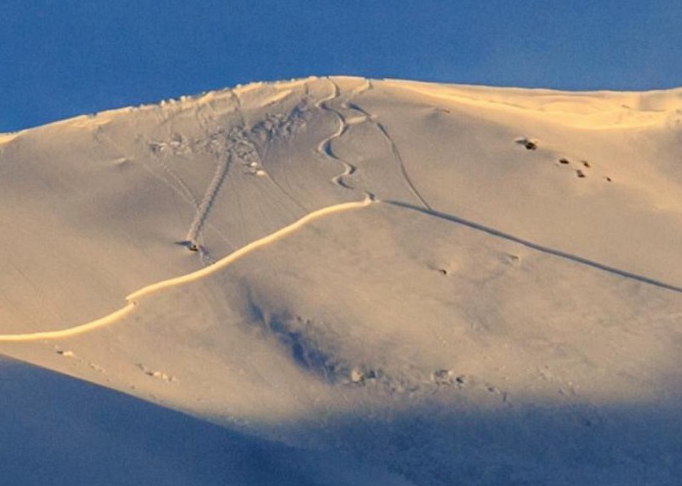Northern Exposure
 Monday, December 22, 2014 at 03:11PM
Monday, December 22, 2014 at 03:11PM  Sunburst Ridge, Turnagain Pass, AKIn spite of the grim, dry and warm weather around Anchorage so far this winter, the precipitation has been pumping through the Kenai Penninsula and dumping snow up high. The road is still mostly dry requiring some walking through the alders to get to the goods but at least there's skiing. However, the funky weather patterns have created some sketchy deep layers that shed some light on the realities of Alaska skiing that I think are worth discussing. Slick rain crusts and buried surface hoar are currently persistant worries for all who venture up there.
Sunburst Ridge, Turnagain Pass, AKIn spite of the grim, dry and warm weather around Anchorage so far this winter, the precipitation has been pumping through the Kenai Penninsula and dumping snow up high. The road is still mostly dry requiring some walking through the alders to get to the goods but at least there's skiing. However, the funky weather patterns have created some sketchy deep layers that shed some light on the realities of Alaska skiing that I think are worth discussing. Slick rain crusts and buried surface hoar are currently persistant worries for all who venture up there.
No where to hideAlaska is known for thick, sticky snow packs that are typically stable. All that ski porn you see with the TGR boys shredding 50 degree spine lines is made possible by a combination of meteological factors unique to this area. And when this stuff is going off, the skiing is ridiculously fun. But trusting this kind of set up takes some getting used to. The most popular zone near Anchorage is Turnagain Pass which features an almost unlimited number of 1,500 to 2,500 foot lines of consistent fall line skiing with neary a feature between your launch and the bottom. I grew up back country skiing leap frogging from "island of safety" to island of safety, spotting my partners during the descent.
On these giant slopes up here, that style pretty much goes out the window. It's unnerving. There's simply no where to hide mid slope. So, you bring your fat skis and strong quads and be prepared to take it to the bottom at speed. And, above all else, know your snow pack.
Safer? Maybe. Mat getting snuggled in the ChugachThis quality of skiing in some of the zones up here has me running to the firmer more technical skiing of the Front Range or the rocky couloirs of Hatcher Pass. I simply feel more comfortable in these areas that provide some options for managing objective risk. I know it's never fool proof but it seems safer. It's also a style of skiing that's more engaging to me. Some ice climbing, a rappel or two, a little "dry" skiing....it all just raises the fun factor for me.
But lately, Turnagain has been the only show in town. So, I've had to face my fears if I want to ski. This week, after several feet of fresh snow on top of the above mentioned funkiness, the skies cleared and the usual suspects headed up for the goods. The all-too-classic combination of cabin fever, familiarity, experience, clear skies and fresh powder conspired to provide a near miss for one of the most experienced skiers around that brought me to this post.
As I thought about the burial and the slope involved, a few thoughts occured to me. Given that the avalanche danger rating was high for a few days before and knowing what was lurking beneath the new snow, I wondered why these guys pushed it the way they did. Now, I realize that comments like this are typical Monday morning quarter backing and I don't want to do that, by any means. I wasn't there. But what I will do is put the scenario in context of what we face up here in Alaska that those Outside (lower 48) don't face. I submit that if the same conditions existed in the Tetons, no one would consider venturing onto a similar slope. I would've simply headed to any number of gladed zones and enjoyed the day with a significantly lower likelyhood of a similar result. But here, we really don't have that option as most of the skiing is above treeline. It's simply what you face to ski up here. And therein lies the rub.
Luckily, the buried skier was fine with only a lost pole to show for his misfortune. He returned to ski the next couple of days and all is right in the world once again. Mat and I went up to Sunburst a few days later and skied with this guy and his crew. The snow pack had stabilized a bit in the intervening 72 hours but we still avoided that aspect and slope angle. We managed about 7,000 feet of fun powder skiing under calm skies with just a handfull of others. Still, it was interesting to see us "creep" around the aspect we started out skiing, venturing closer to the slide area. In spite of my hackles being up, we were still exposed to the same forces that, perhaps, led to the event days earlier.
Also on display this day was the impact that collective decision making has on the tribe. When a slope gets skied successfully, following skiers either consciously or sub consciously feel "safer" skiing it. I think this phenomenon leads to the "exposure creep" I mentioned above. Of course, there are numerous examples of skied slopes failing after the fifth, sixth or seventh skier descends. These instances highlight the falibility of this type of stability testing. Be safe out there.
 Brian |
Brian |  Post a Comment |
Post a Comment |  Turnagain Pass,
Turnagain Pass,  avalanche,
avalanche,  back country skiing in
back country skiing in  General
General 





Reader Comments